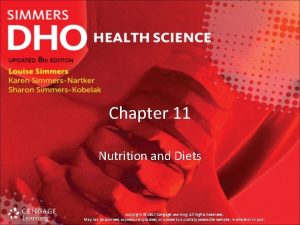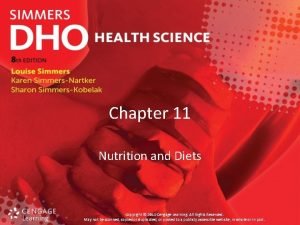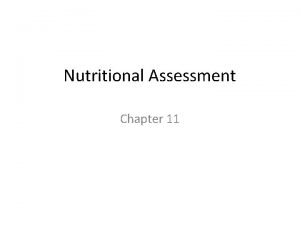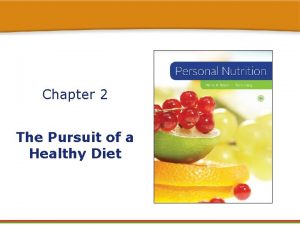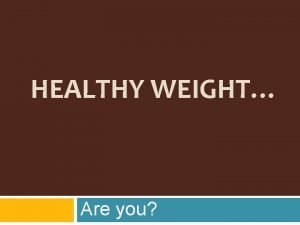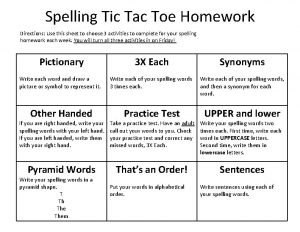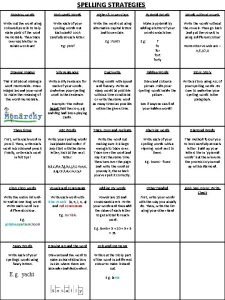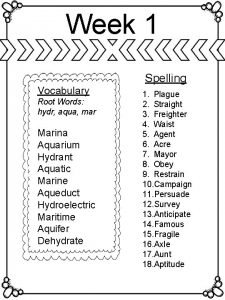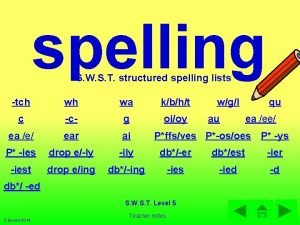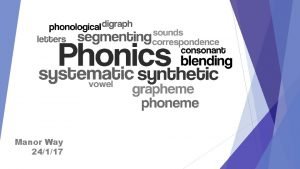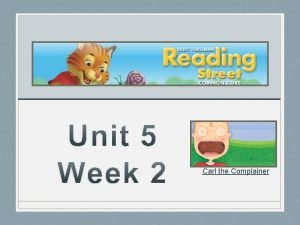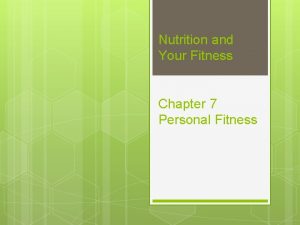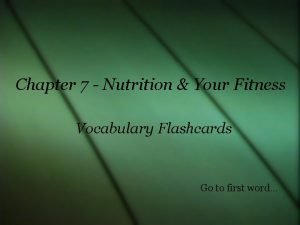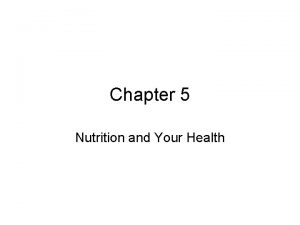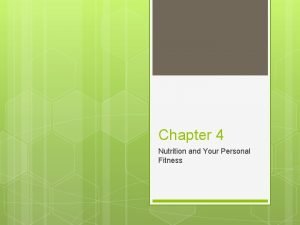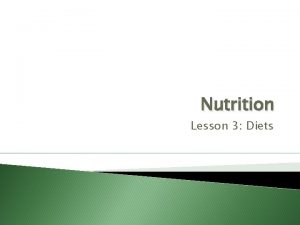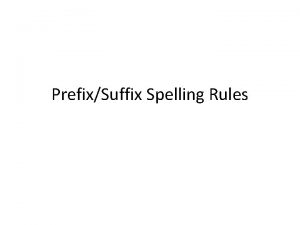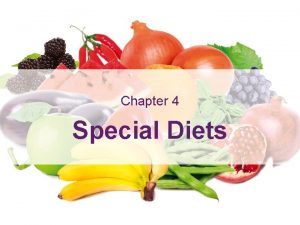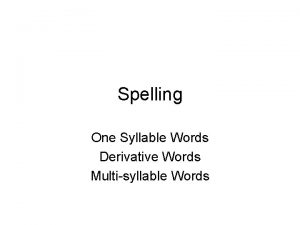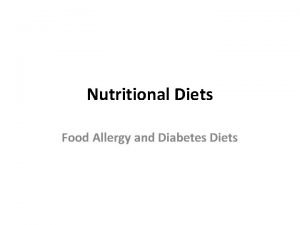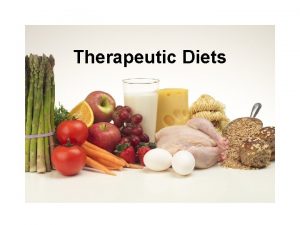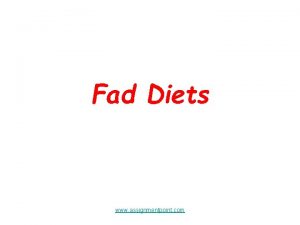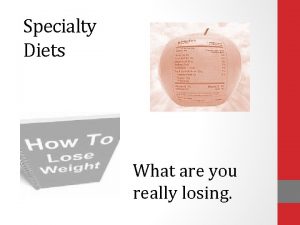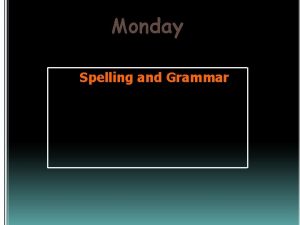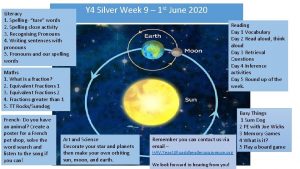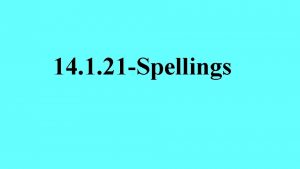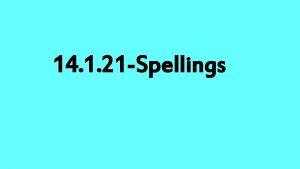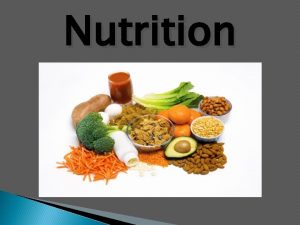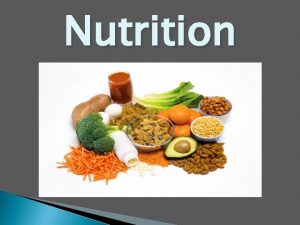Chapter 11 Nutrition and Diets Spelling Words for
































- Slides: 32

Chapter 11 Nutrition and Diets

Spelling Words for Chapter 11 nutrition nutrient carbohydrate cellulose lipid obesity

Define Terms Nutrition Cholesterol Malnutrition Protein Carbohydrates Lipids (Fats) Vitamins

Nutrition What is nutrition? The body’s use of food for growth, development, and health. It includes all body processes (digestion, absorption, metabolism, circulation, elimination) related to food. These processes are the way our body uses the food for energy, growth and maintaining our health. Wellness is a state of being in good health.

Malnutrition - poor nutrition, may be caused by diet or illness Symptoms? Fatigue, depression, being overweight or underweight, poor skin and hair, irritability. What can it cause? Deficiency diseases (like scurvy), poor muscular and skeletal development, reduced mental abilities and in severe cases, death. Who is more likely to be affected? Elderly, teens, young children, those living in extreme poverty, and patients undergoing drug therapy (cancer patients).

Malnutrition (continued) Obesity is a form of malnutrition, caused by excess food consumption.

BELLRINGER: Write the following and the answer. Pages 286 -288 1. Identify the six groups of essential nutrients. Carbohydrates, proteins, vitamins, minerals, water, lipids 1. Identify four functions of water in the body. Digestion (breakdown) of food, makes up blood plasma and cytoplasm, helps body tissues absorb nutrients, helps move waste through the body

Essential Nutrients What are essential nutrients? They are elements in food required by the body for proper functioning. Essential nutrients are divided into 6 groups: Carbohydrates Vitamins Lipids (fats) Minerals Proteins Water

Essential Nutrient - Carbohydrates ● Major source of readily usable energy ● Called starches or sugars EXAMPLES: Breads, cereal, pasta, crackers, potatoes, corn, peas, grains, fruit, sugar What is cellulose? It’s the fibrous form of carbohydrate. What does it do? Puts bulk in the digestive system for bowel movements. Examples: bran, whole grain, apples, bananas, sweet potatoes

Essential nutrient - Lipids (fats) Lipids are commonly called fats and oils. Fats provide the most concentrated form of energy. Examples: butter, oil, heavy cream, fatty meat, cheese, egg yolk What is cholesterol? A type of lipid found in body cells and animal products. What’s it for? Used to make hormones, vitamin D and bile acids. HDL - “Good” cholesterol LDL - “Bad”

Essential Nutrient - Protein Need protein to build and repair tissue, regulate body functions, provide energy and heat Amino acids are the building blocks of proteins. Examples of protein: meat, fish, milk, cheese, eggs

Essential Nutrient - Vitamins Organic compounds necessary for body processes What are they used for? Metabolism, tissue building, regulating body processes Antioxidants - Some vitamins are antioxidants. They help protect the body from harmful chemicals called free radicals. Found mainly in fruits and vegetables with main antioxidants being vitamins, A, C, & E. Vitamin A Vitamin C Vitamin E

Essential Nutrient - Minerals Inorganic substances essential to life What do they do? Regulate body fluids, assist in body functions, aid in building tissues. Examples: zinc (seafood, eggs, milk), selenium (seafood, organ meats), Copper ( nuts, whole grains, organ meats) and magnesium (meat, seafood, fresh green vegetables).

Essential Nutrient - Water Found in all body tissues 1. 2. 3. 4. Used in the digestion of food Makes up blood plasma and cytoplasm of cells Helps body tissue absorb nutrients Helps move waste through the body How much water should the average person drink a day? 6 to 8 glasses a day

Bellringer: Page 292 Write the following and answer. Name the 5 food groups and give three examples of food in each group. Protein, dairy, vegetables, fruits, grains Name three foods you have eaten in the past 24 hours and tell what food group each is in.

Using nutrients in the body: Digestion Absorption Metabolism

Using nutrients in the body What is digestion? The body breaks down food into smaller parts, changes the food chemically and moves it through the digestive system. Peristalsis - food is moved through the digestive tract by peristalsis which is a rhythmic, wavelike motion of the muscles.

Using nutrients in the body What is absorption? Blood or lymph capillaries pick up the digested nutrients and then the circulatory system carries those nutrients to cells What is metabolism? Nutrients are used by the cells for building tissue, providing energy and regulating body functions. Basal Metabolic Rate (BMR) : rate at which the body uses energy just for maintaining its own tissue, without doing any voluntary work.


Bellringer: Page 296 Write the following and answer: What is the difference between being overweight and being obese? Overweight is 10 to 20 percent body weight over the average recommended weight for a person’s height and obesity is body weight over 20 percent of the recommended weight for a person’s height.

List 6 conditions that can develop as a result of obesity. hypertension sleep apnea diabetes heart disease stroke high cholesterol osteoarthritis gallbladder disease colon cancer

Diseases that may be related to poor nutrition: Hypertension: high blood pressure, may be caused by excess salt or fat in diet Atherosclerosis: fatty substances on the inside of the arteries have caused a narrowing of the arteries, thought to be caused by diets high in saturated fats and cholesterol

Diseases that may be related to poor nutrition: Osteoporosis: bones develop tiny openings which cause them to break easily, one cause is not enough vitamin D and calcium Osteoporosis means porous bone.

Diseases that may be related to poor nutrition: Diabetes mellitus: metabolic disease caused by insufficient secretion or use of insulin, this leads to an increased amount of sugar in the blood and urine. What increases chances of developing diabetes? Heredity Obesity Lack of exercise Diets high in carbs and sugar

Let’s Review ! https: //quizlet. com/_61 be 4 g

Therapeutic Diets What is a therapeutic diet ? A diet used to improve or treat specific health conditions. What kind of changes are made to the food? ● Calorie content ● Texture ● Nutrient content

Therapeutic Diets Regular Diet ● Balanced diet ● Patient does not have dietary restrictions ● May or may not have reduced calories

Therapeutic Diets Liquid Diet ● includes clear liquid diet and full liquid diet ● Used for short periods of time (surgery, infections, vomiting, diarrhea) Clear Liquid Apple/grape juice Jello Fat free broths Tea / black coffee (with sugar) Full liquid Yogurt Hot cocoa Ice cream Milk

Soft Diet - Therapeutic Diets ● foods must require little chewing, easy to digest ● used following surgery, dysphagia (difficulty in swallowing), digestive disorders ● food may sometimes be pureed (blended) AVOID ● Tough meat, spicy food, fried foods, nuts, raw fruits and raw vegetables

Therapeutic Diets Diabetic Diet ● Used for patients with diabetes (body does not produce enough insulin) ● Patients have to calculate amount of carbs they eat Sugar-heavy foods such as desserts, syrup, candy and jelly are avoided.

Therapeutic Diets Sodium- Restricted Diet (also called low salt diet ) ● Patients avoid adding salt to food ● Avoid smoked meats, processed food, pickles, olives, processed cheeses Examples of patients that may have to be on a low salt diet include those with heart diseases and kidney disease.

Therapeutic Diets Low Protein ● Patients that may need to be on a low protein include those with kidney disease and certain allergies ● Foods to limit on a low protein diet include meat, fish, milk, eggs
 Chapter 11 nutrition and diets key terms
Chapter 11 nutrition and diets key terms Test chapter 11 nutrition and diets
Test chapter 11 nutrition and diets Chapter 11 nutrition and diet
Chapter 11 nutrition and diet Nutritional status assessment
Nutritional status assessment Lewis and clark and me spelling words
Lewis and clark and me spelling words Diets based on only one basic food element
Diets based on only one basic food element Most fad diets do follow the mypyramid guidelines
Most fad diets do follow the mypyramid guidelines Fad diets def
Fad diets def Words their way upper level spelling inventory
Words their way upper level spelling inventory Words their way spelling tests
Words their way spelling tests Wrat 4 test
Wrat 4 test Exhibit past tense
Exhibit past tense April spelling tic tac toe
April spelling tic tac toe How to spell bee in spanish
How to spell bee in spanish Outspoken in a sentence
Outspoken in a sentence Thunder rose spelling words
Thunder rose spelling words Stage 3 spelling words
Stage 3 spelling words Red kayak spelling words
Red kayak spelling words Old yeller vocabulary pdf
Old yeller vocabulary pdf Old yeller spelling words
Old yeller spelling words Thunder rose spelling words
Thunder rose spelling words Backwards spelling bee
Backwards spelling bee Spelling words
Spelling words Hosp root word
Hosp root word Au words list
Au words list Words for year 1
Words for year 1 Spelling lesson 2: content words
Spelling lesson 2: content words Carl the complainer spelling words
Carl the complainer spelling words Nutrition words
Nutrition words Chapter 7 nutrition and your fitness
Chapter 7 nutrition and your fitness Fitness chapter 7
Fitness chapter 7 A saturated fatty acid holds all the hydrogen atoms it can.
A saturated fatty acid holds all the hydrogen atoms it can. Chapter 4 nutrition and your personal fitness
Chapter 4 nutrition and your personal fitness
